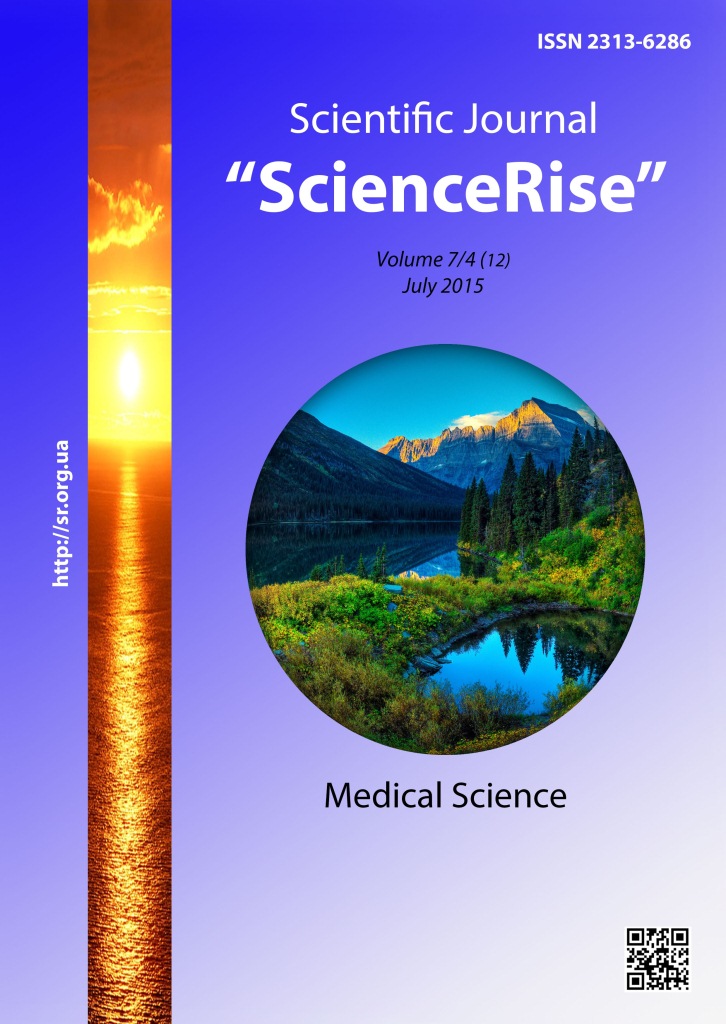Route of children at ulcerative gastroduodenal bleedings
DOI:
https://doi.org/10.15587/2313-8416.2015.47380Keywords:
children, gastroduodenal bleeding, ulcerative disease, algorithm of diagnostics and treatment.Abstract
Aim. To elaborate the step-by-step differential algorithm of the motion of children with ulcerative gastroduodenal bleedings.
Methods. There were examined 45 patients with gastroduodenal bleeding of ulcerative genesis using clinical, sociometric, genealogic, immune-enzyme, biochemical, endoscopic, functional methods. In the complex treatment for stop bleeding 13 patients underwent argon-plasma coagulation and the other – irrigation with aminocapronic acid. An efficiency of treatment was evaluated using epidemiologic and statistical methods.
Results. At presence of an appropriate clinical symptomatology, burdened genealogic anamnesis, laboratory changes it is necessary to carry out an emergency endoscopic examination. In the case of continuing bleeding or instable homeostasis it is recommended to carry out an endoscopic hemostasis using argon-plasma coagulation, in conditions of the high risk of relapse of bleeding – the repeated course of argon-plasma coagulation. After stabilization - an examination for helicobacter infection, conservative therapy and dynamic observation with detection of risk of relapse of bleeding and elaboration of individualized medioprophylactic program.
Conclusions. The use of step-by-step differentiated diagnostic and treatment algorithm of the motion in patients with ulcerative disease complicated with gastroduodenal bleeding allows detect the main spectrum of diagnostic researches faster and choose the tactics of treatment and therefore improve an efficiency of medical help for patient and shorten the term of inpatient treatment.
References
Dinis-Ribeiro, M. (2013). Gastrointestinal bleeding. Gastrointest. Endosc., 78 (3), 434–438. doi: 10.1016/j.gie.2013.06.021
Zaprudnov, A. M., Grigor'ev, K. I., Dronov, A. F. (1998). Zheludochno-kishechnye krovotechenija u detej [Gastrointestinal Bleeding in Children]. Moscow, Russia: Medicine, 207.
Parhomenko, L. K., Glebova, T. A., Strashok, L. A., Zavelya, E. M., Isakova, M. Yu., Eschenko, A. V. (2006) Oslozhneniya yazvennoy bolezni v podrostkovom vozraste [Complications of peptic ulcer disease in adolescence]. Meditsina Neotlozhnyih Sostoyaniy, 5 (6), 36–38.
Fomіn, P. D. (2012). Udoskonalenі algoritmi dіagnostiki ta lіkuvannja gostroi shlunkovo-kishkovoi krovotechі: Metodichnі rekomendacіi [Improved algorithms for diagnosis and treatment of acute gastrointestinal bleeding: Guidelines]. Kyiv, Ukraine, 108.
Timerbulatov, V. M., Timerbulatov, Sh. V., Sagitov, R. B. (2010). Gemostaz pri ostryih zheludochnokishechnyih krovotecheniyah [Hemostasis in acute gastrointestinal bleeding]. Hirurgiya. zhurn. im. N. I. Pirogova, 3, 20–26.
Doletskiy, S. Ya., Strekalovskij, V. P., Klimanskaja, E. V., Surikova, O. A. (1984). Endoskopiya organov pischevaritelnogo trakta u detey: monografiya [Endoscopy of the digestive tract in children]. Moscow, Russia: Medicine, 280.
Bregel, A. I., Evtushenko, V. V., Hantakov, A. M., Mutin, N. A. (2012) Arogonoplazmennaya koagulyatsiya pri yazvennom gastroduodenalnom krovotechenii [Arogon plazma coagulation ulcerative gastroduodenal bleedings]. Byuleten VSNTs SO RAMN, 4 (86), 26–27.
Sokolnik, S. O. (2015). Porivnyalna efektivnist metodiv endoskopichnogo gemostazu pri uskladneniy krovotecheyu virazkoviy hvorobi v ditey [Comparative efficacy of endoscopic methods of hemostasis in bleeding peptic ulcer complicated in children]. ScienceRise, 5(4 (10)), 103–106. doi: 10.15587/2313-8416.2015.43303
Li, Y. R., Hsu, P. I., Wang, H. M. et al. (2014). Comparison of hemostatic efficacy of argon plasma coagulation with and without distilled water injection in treating high-risk bleeding ulcers. Biomed. Res. Int., 2014, 1–6. doi: 10.1155/2014/413095
Levenstein, S. (1999). Peptic ulcer at the end of the 20th century: biological and psychological risk factors. Can. J. Gastroenterol., 13 (9), 753–759.
Downloads
Published
Issue
Section
License
Copyright (c) 2015 Сергій Олександрович Сокольник

This work is licensed under a Creative Commons Attribution 4.0 International License.
Our journal abides by the Creative Commons CC BY copyright rights and permissions for open access journals.
Authors, who are published in this journal, agree to the following conditions:
1. The authors reserve the right to authorship of the work and pass the first publication right of this work to the journal under the terms of a Creative Commons CC BY, which allows others to freely distribute the published research with the obligatory reference to the authors of the original work and the first publication of the work in this journal.
2. The authors have the right to conclude separate supplement agreements that relate to non-exclusive work distribution in the form in which it has been published by the journal (for example, to upload the work to the online storage of the journal or publish it as part of a monograph), provided that the reference to the first publication of the work in this journal is included.

